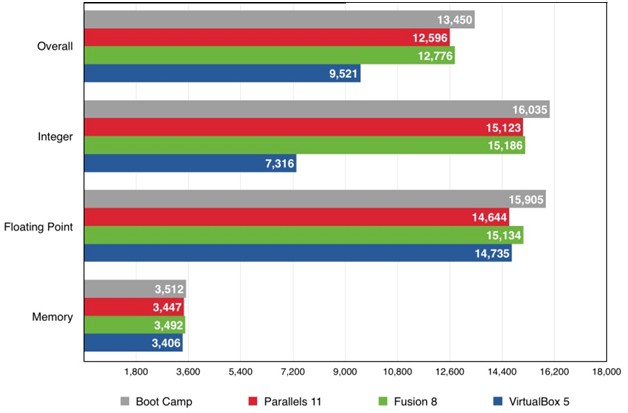

- VMWARE VS PARALLELS FOR MAC
- VMWARE VS PARALLELS PRO
- VMWARE VS PARALLELS SOFTWARE
- VMWARE VS PARALLELS PC
- VMWARE VS PARALLELS FREE
Ive been virtualizing my Windows environment on the Mac since the first Intel Mac came about.
VMWARE VS PARALLELS PRO
These results were achieved using a MacBook Pro with nVidia GeForce 650M graphics, 1280×800 resolution and Medium detail… Both VMware and Parallels offer solid performance and useful features when running Windows on a Mac. Answer (1 of 4): They are all evolving and the answer will shift depending on which has the most recent version released. Fusion hit a playable 52fps in Stalker: Call of Pripyat, while Parallels added almost a third more frames at 69fps. Harrison reports, “Graphics performance shows the largest difference.
VMWARE VS PARALLELS FOR MAC
Using near-matched configurations of Windows 7, two active processor cores and 2GB of memory, Parallels scored 4,305 points in PCMark 7, 8.6 percent faster than Fusion’s 3965.”Īdvertisement: Limited time offer – 25% off Parallels Desktop 8 for Mac – Run windows on your Mac – Faster “In performance terms, Parallels continues its lead over Fusion with consistently faster results in our benchmarks. “Either of the latter are easier to work with than VirtualBox, with broadly similar qualities and very decent performance,” Harrison reports.
VMWARE VS PARALLELS FREE
“There are three clear options: the open-source and free but limited VirtualBox, or one of the two commercial packages, Parallels Desktop 8 for Mac or VMware Fusion.”
VMWARE VS PARALLELS PC
The product is simply better developed right now.“Running Windows 8 or Windows 7 on a Mac or a MacBook is simple with virtualisation software, so you need never have to reboot to switch operating systems again,” Andrew Harrison reports for PC Advisor. I think Fusion is coming on fast and VMWare’s extensive experience in virtual technology may give them the advantage in the future, however Parallels currently has extensive experience with Mac-specific virtual machines. To me, this suggest that Parallels is able to utilize the Mac hardware more efficiently. However, Parallels gave the EXACT same windows machine (migrated in after being built in Fusion) a score of 3.9. However, Fusion 3 gave me a "windows performance score" of 2.0 (up from 1.0 in Parallels v4 and Fusion v2). Parallels has been winning about 80% of the reviews in side-by-side comparisons.īoth programs ran XP similarly, although Parallels seemed to render the screen a bit cleaner (fonts are smoother). (granted, this is just 'candy' - not really useful). There’s and App for that –Parallels has an iPhone app that lets you control your VM. Parallels fully supports the new track pad gestures better (and the new Magic Mouse). The features with Parallels are better developed and more stable for the time being. Parallels is (claimed) 300% faster than version 4, which was a HUGE improvement already over version 3 (which is what we were upgrading most clients from). and briefly tried Virtual Box.ĭropped virtual box immediately because it is not yet developed enough or nearly as stable as the other two.Įither Parallels or Fusion will work moving forward but the following items tipped the scale toward Parallels for us (for now): VMware does not have this strict of a limitation, if any at all. Fusion beats Parallels when it comes to needing to run the program on multiple machines. We did pretty extensive testing on Parallels 5 and Fusion 3. Parallels: My benchmark scores have Fusion having a bit better benchmarks, however, iirc correctly, it was basically insignificant. Parallels management tools (purchased separately) supports centrally managing VM Hosts across their platform and product lines, except for Desktop. Eventually they will officially support it. Parallels BareMetal Server (while not officially supported due to licensing issues with Apple) does run on the Xserve with a special boot loader image they can provide. pvm files and runs as a service so the user does not need to be logged in for VMs to continue running. Parallels also has Parallels Server for Mac which runs on OS X Server (normally on an Xserve or Mac Pro with OS X Server installed) which is compatible with the Parallels Desktop for Mac.
VMWARE VS PARALLELS SOFTWARE
What I’ve garnered from the forums is that VMware pushed out Fusion just so they could say they had the first Desktop Virtualization software for the Mac. At least they haven’t said anything publicly about it. Fusion is VMware’s only Mac product and it doesn’t look like they’re going to extend out to anything beyond desktop level virtualization than that. I ended up choosing Parallels because Parallels has a more committed “Mac Camp” than VMware at the same pricing with the same performance (except for PDfM 5). Parallels 5 however shows better performance than Fusion at this point. Feature-wise Fusion and Parallels are pretty much on par with each other. VirtualBox “will work” but doesn’t have the performance of either Fusion or Parallels. I’ve used all three Fusion, Parallels and VirtualBox.


 0 kommentar(er)
0 kommentar(er)
